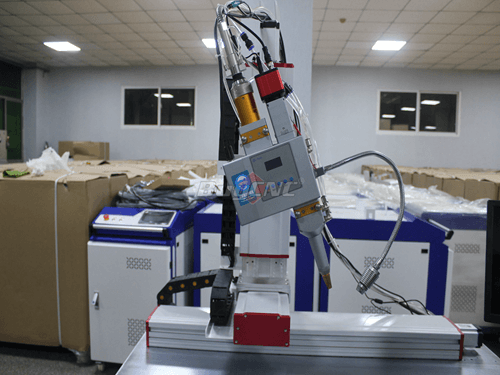Table of Contents
The Principle of Laser Welder
Laser welder uses high-energy laser pulses to locally heat the metal in a small area. The energy of the laser radiation is diffused into the metal through thermal conduction, so that the material is melted to form a specific molten pool. This is a new type of welding laser welding mainly aimed at welding thin-walled metals and fine parts.
BuyCNC’s laser welder can realize spot welding, butt welding, stitch welding, sealing welding, etc. It has the advantages of high aspect ratio, small weld width, small heat affected zone, small deformation, fast welding speed, smooth and beautiful weld, no or simple processing after welding, high weld quality, no pores, accurate control, and focused spot. Small size and high positioning accuracy.
The principle of Laser welder can be divided into heat conduction welding and laser deep penetration welding. When the power is less than 104~105W/cm2, it is heat conduction welding, and the welding speed is slow.
When the power density is greater than 105~107W/cm2, the metal surface is recessed into a “cavity” under the effect of heat, forming a deep penetration welding, which has the characteristics of fast welding speed and large aspect ratio.
Laser deep penetration welding When a high power density laser beam shines on the metal surface, the metal absorbs light energy and converts it into heat energy. The metal is heated, melted and vaporized, and a large amount of metal vapor is generated. The molten metal liquid is pushed out to form the crater under the reaction force that occurs when the steam leaves the surface.
As the laser continued to shine, the pit penetrated deeper and deeper. When the laser stops shining, the molten liquid around the pit flows back. After cooling and solidification, the two weldments can be welded together.

How to improve the quality of laser welder
With the continuous emergence of laser welder, more and more general-purpose equipment suitable for the use of the masses will appear. In the future, laser welder may enter thousands of households like an electric welding machine and become a common equipment. Like all welding, laser welding also has corresponding skills. And methods can prevent and reduce the shortcomings of welding.
Only by preventing the occurrence of these shortcomings, can we better process products with good appearance and small welding deformation and high weld bead strength. Next we’ll show you how to prevent the three main problems of laser welders.
Cracks: The cracks in the laser welder are mainly thermal cracks, crystallization cracks, liquefaction cracks, cracks caused by impurities and foreign matter, etc. The main reason for the occurrence is that the welding seam has a large shrinkage force before it is completely solidified. Wire filling, preheating , and other methods can reduce or eliminate cracks.
Porosity: Porosity is a disadvantage that easily occurs in laser welding. The molten pool of laser welding is deep and narrow, and the cooling rate is very fast. The gas generated in the liquid molten pool does not have enough time to escape, which easily leads to the formation of pores. However, laser welding cools quickly, and the porosity that occurs is generally smaller than that of traditional fusion welding. Cleaning the surface of the workpiece before welding can reduce the tendency of porosity, and inert gas protection can reduce the metal oxidation reaction and inhibit the occurrence of porosity. In any case, it is better to be as close as possible to the weld bead.
Splash: The splash generated by the laser welder seriously affects the surface quality of the weld, and will contaminate and damage the lens. The most important thing about spatter is that the focal length of the laser is directly proportional to the power density. It is necessary to readjust the welding focus by using different welding parameters. The spatter can be reduced by changing the focus and reducing the welding power. In the case of lack of penetration, the welding speed can be reduced to achieve the intention of increasing penetration.

How to maintain laser welder
Then when we buy a laser welder, we must understand its maintenance method, so that the laser welder can have a long service life, which is beneficial to us, then BuyCNC will give you a brief explanation.
When the laser welder has been working continuously for two weeks or has been used for a long period of time, check the components in the laser light path such as semiconductor rods, dielectric diaphragms and zoom lens maintenance glass before starting to make sure that all electronic and optical components are There is no abnormal situation such as severe dust pollution and mildew.
If the above situation occurs, it should be dealt with immediately to ensure that the electronic optical components are not easily damaged under the direct irradiation of strong laser beams. (If the application field of the equipment is relatively neat, the above inspection can be relatively extended to 1 month or even longer).
The purity of the cooling circulating water is the key to ensure the output efficiency of the laser beam and the service life of the laser generator concentrating cavity components. During use, the conductivity of the inner circulating pure water should be checked once a week to ensure that its conductivity is 30%.
The double-distilled water in the internal circulation needs to be replaced once a month, and the conductivity of the newly introduced pure water needs to be 32MW cm. Pay attention to check the color change of the positive ion replacement column in the refrigeration management system anytime, anywhere. Once you find the epoxy resin in the replacement column. If the color becomes dark red or even gray-black, the epoxy resin should be replaced immediately.
Laser Welding Machine For Sale


